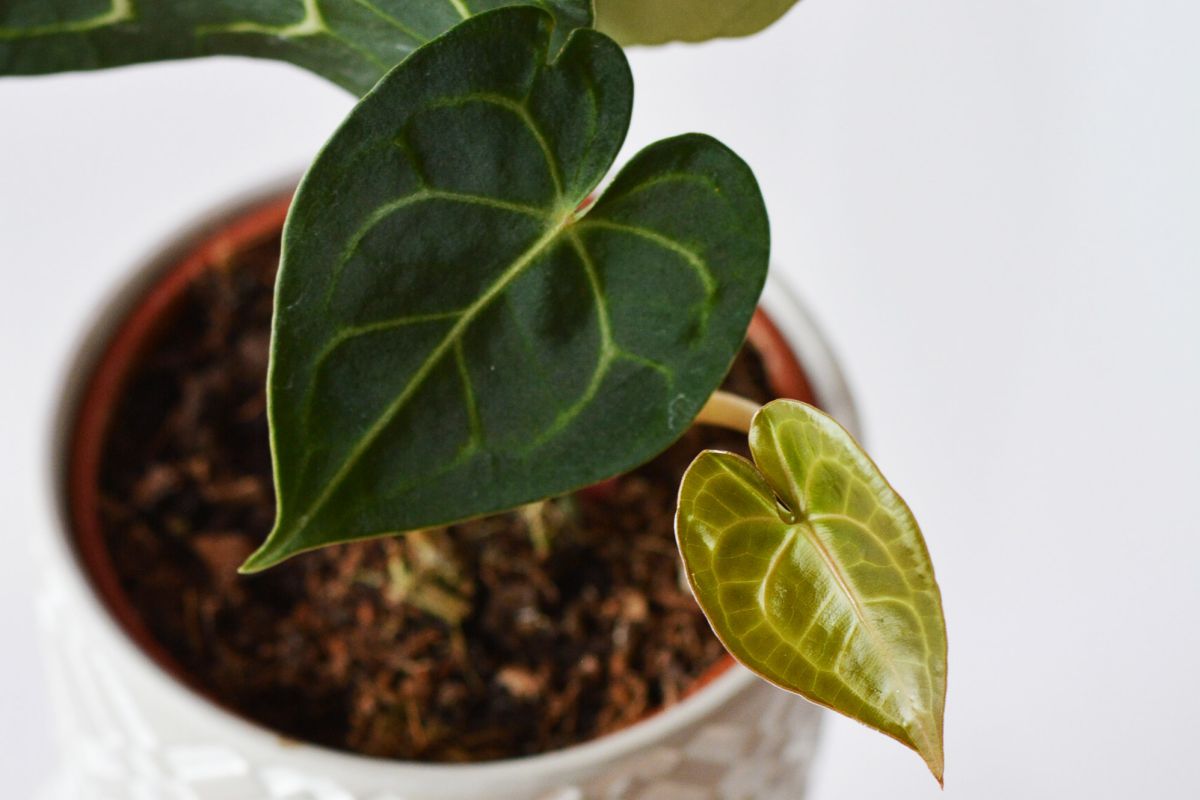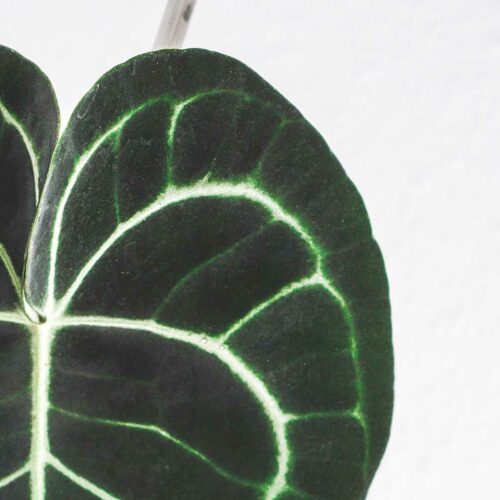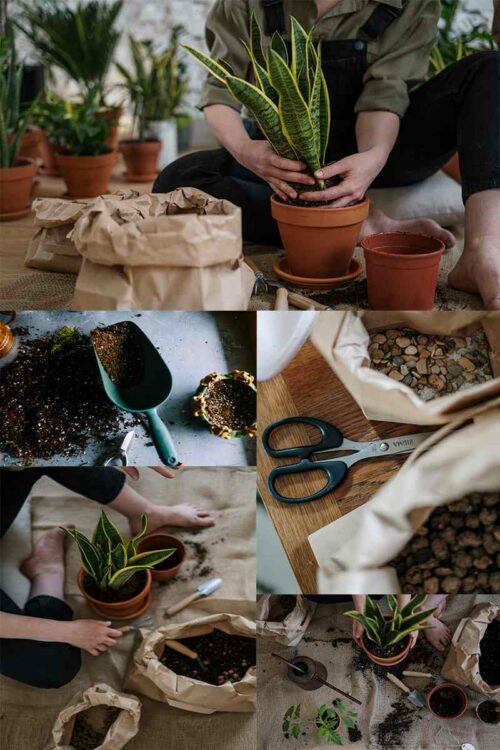How to care for an Anthurium? How much light does an Anthurium need? What is the best potting mix for the Flamingo Flower? Why is my Anthurium not blooming?
Rare Anthuriums are grown for their foliage while the common Anthuriums, the Flamingo Flower, are grown mostly for their stunning and colourful blooms. If an Anthurium has joined your plant-family, the above questions might be going through your mind. This article is for you as it will teach you how to keep your Flamingo Flower happy and healthy and will answer common Anthurium care related questions.
Indoor Anthurium care is pretty straightforward. The plants from the Alocasia genus are usually not considered beginner-friendly. This is not because the plants require any special care but because Alocasia wants its owner to stay on top of its needs. This complete Anthurium care guide will cover all the main carerequirements and needs that the Flamingo Flower has when grown as a houseplant. things you need to know to help you keep your Elephant’s Ear happy, healthy, and thriving.
Anthurium is a genus of flowering plants, including more than 1000 different varieties, which makes it the largest genus amongst aroid plants (family Araceae, or arum). The Flamingo Flower grows usually as an epiphyte (meaning on top of other plants or trees), and sometimes in a terrestrial way (on the ground in a crawling pattern). The name Anthurium comes from the Greek word for flower – Anthos. These tropical plants are commonly found in many households, as Anthuriums are easy to maintain, have stunning foliage, and can live happily for many years.
The “flamed” Anthurium and the “Lily-of-the-valley” are commonly chosen Anthuriums due to their uniquely shaped “flowers” that have intense colors. Did you know that actually what we consider a flower on an Anthurium is just a leaf as the true flowers of the Anthuriums are on the spadix, aka the sticky part that comes out of the colorful ‘bloom’. The Anthurium Warocqueanum and the Veitchii, on the other hand, are popular plants amongst plant collectors and are sought after for their uniquely shaped foliage.
Anthuriums generally are low-maintenance plants that can be grown both indoors and outdoors (if the temperatures are warm enough). This detailed plant care guide will cover all the care requirements of an Anthurium so that your Flamingo Flower can grow happily at your home.
This post may contain affiliate links. Read our Privacy Policy and Disclosure here.
Anthurium Houseplant Care – Basic Guidelines
The main Anthurium care needs & requirements are summarized in the table below.
Common Names: Flamingo Flower, Painter’s Palette
Origin: Tropical rainforests of Colombia and Ecuador
Light: bright indirect light
Water: moderately
pH: 5.5 – 6.5
Repot: every 2 to 3 years
Temperatures: 16°C to 28°C (60.8 °F to 82.4 °F)
Humidity: 60% to 75%
Nutrition: balanced fertilizer (eg: 10-10-10) or fertilizer for orchids; a simple NPK fertilizer isn’t enough so ensure that micro elements are also included
Fertilize: 2 times/year with slow release fertilizer or monthly with a liquid fertilizer from March to September; don’t fertilize during the dormant season
Propagation: division, seeds
Pests: aphids, spider mites, thrips, scale insects
Toxic? yes, if ingested
For a detailed guide on how to care for Anthurium, continue reading.
Anthurium Care: Overview
Are Anthuriums easy to care for? Absolutely! Anthuriums are a great (sometimes colorful addition) for all plant lovers as the majority of them are beginner-friendly and don’t require crazy knowledge in the gardening field to grow them successfully. Anthurium care is pretty straight forward: as long as they are provided with enough light, are not left to stay soggy, and are shielded away from direct exposure to heaters, an Anthurium will happily live and flourish in any room that you choose for it.
Anthuriums are considered slow growers compared to Philodendrons but if the plant is mature enough, and the growing season has just started, it might surprise you with producing a leaf after a leaf and soon enough: your elegant Anthurium might become gigantic. The good news here is: Anthuriums are incredibly easy to propagate so if your Flamingo Flower has outgrown its spot, you can easily prune it back a bit and create small Anthuriums.
1. How Much Light Does an Anthurium Need?
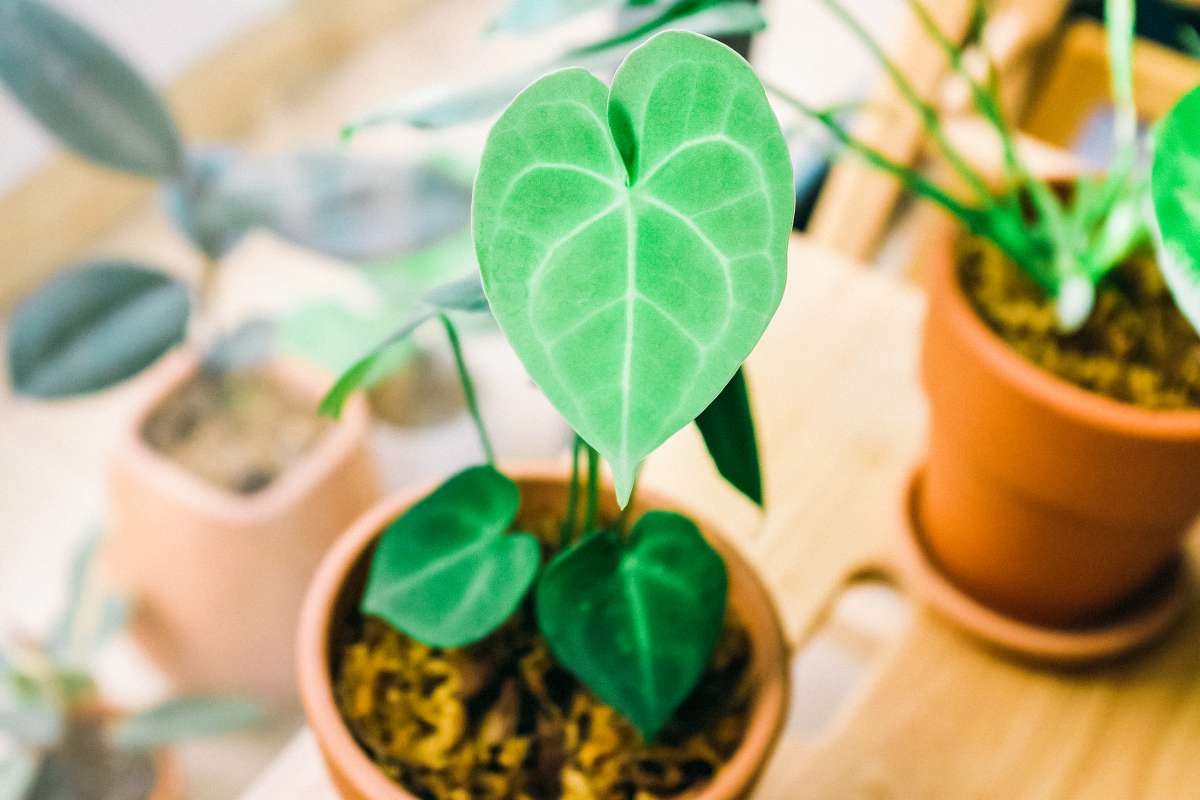
Oh, during the growing season, these tropical plants go crazy for light, especially the Anthurium Clarinervium. It is as if their leaves start growing at impossible angles and ways just to absorb every single ray of light. I have one that I call the “Moon Dancer” because its leaves resemble the infamous Moon Walk.
So with that in mind, give your Anthurium all the light you can during the growing season (i.e. Spring and Summer) so that it can thrive and produce those stunning leaves that we all just love. Light is also a vital component if you want your Anthurium to bloom. If you don’t see any flowers on your Anthurium during the growing season, this could be an indication that the plant is not receiving adequate lighting (amongst other things). If you feel like your Anthurium’s light needs aren’t met, you can always supplement it with a grow light to give it an extra boost and in a short time, your aroid should respond to it by speeding up its growth.
How much light (PAR) do Anthurium need? During the growing season, the best PPFD for an Anthurium to ensure optimal growth is between 100 to 500 umol/m2/s with a daily lighting period of 12 to 14 hours.
How much lux (foot candles) do Anthurium plants need? You should aim to provide your Anthurium with at least 1,000 lux (100 foot candles) to ensure survival. If you want your Anthurium to grow faster, provide it with a light source of around 4, 000 lux (400 foot candles). However, if the lux measures above 10, 000 (1, 000 foot candles), check if your Anthurium tolerates well the strong light without any leaves getting scorched.
To measure the lux number (or the PPFD), use a lux meter, also known as light meter.
A location that receives bright, indirect light would be the ideal sweet spot for your Flamingo Flower. Make sure that your plant is protected from direct sun exposure, as the foliage of Anthuriums might get scorched if the sun is too much for them.
During the dormant season, however, (Autumn and Winter), your Anthurium will also tolerate partial shade as they become semi-dormant and Save growth significantly slows down. This means that, although you can choose to supplement your Anthurium with a grow light during the seasons when there are fewer hours of natural daylight, it is not a must to do so.
If you are unsure what “bright indirect light” means or how to find the ideal spot for your Anthurium at home, make sure to check out our detailed Plants Light Guide.
2. How often to water an Anthurium?
It’s very important to ensure that you are doing your best to avoid overwatering your Flamingo Flower. Root rot is a common issue with Anthuriums which is in most cases caused by keeping their soil too wet, also called ‘wet feet’.
Anthuriums need frequent irrigations but at the same time, they absolutely hate it if they have wet feet. The key when watering an Anthurium is to make sure that the plant has slightly dried out (but not fully!) between waterings.
Droopy leaves on an Anthurium are a sign that you are behind on your watering, so you need to adjust it promptly as Anthuriums that are distressed can drop leaves quite fast, and new foliage might grow distorted and underdevelop when the plant is not receiving enough water.
Overwatered Anthuriums, on the other hand, show signs of edema and yellow spots, which later turn brown might develop on the leaves.
It’s all about finding the sweet spot when it comes to watering your Anthurium.
How do you know when it is the right time to water your Anthurium?
Use your finger! For smaller pots, insert your index finger and if the soil feels dry up to the first knuckle, water your plant thoroughly (make sure water is coming out of the drainage hole). For larger pots, check the soil level up to your second knuckle on your finger or even deeper. Alternatively, there are a lot of moisture meters available online but always consider their accuracy with a grain of salt until proven to work flawlessly.
You might wonder: how often to water an Anthurium?
Do not rely on a watering schedule when it comes to your Flamingo Flower, it would not work well. This is because in Autumn and Winter, Anthuriums gradually slow down their growth and become semi-dormant and that is the moment when you have to be extra careful to not overwater them. While during the hot summer months, they sometimes seem to need water daily. So make sure to make it a rule to always check the moisture level of the plant’s soil before watering it.
Sometimes, if the water used to water your Anthurium is too hard, minerals build up can start showing on the leaves, this is why, whenever possible, water your Flamingo Flower with rainwater or at least water that has been allowed to stay overnight.
For a detailed guide on what are the best practices to water houseplants and things like: bottom-watering versus top-watering, read our article on Watering Houseplants.
3. What is the Best Potting Mix for an Anthurium Grown Indoors?
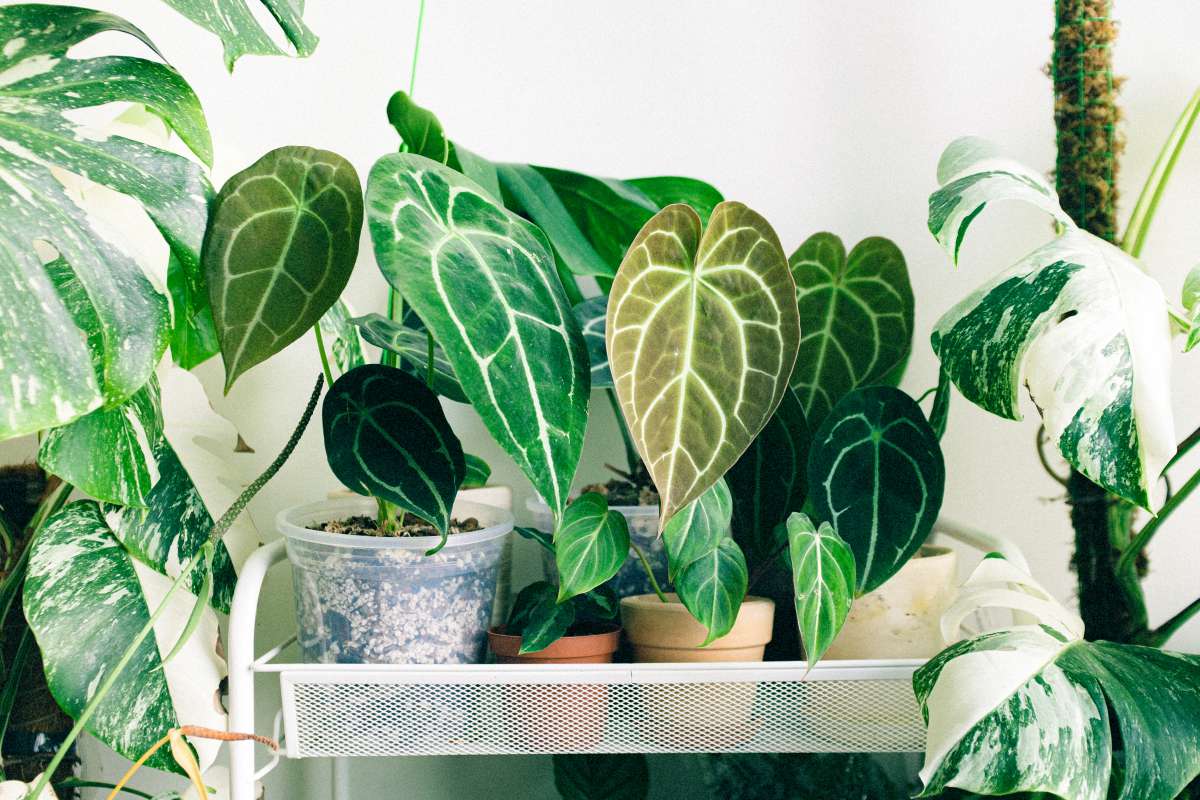
Your Anthurium will absolutely love it if you plant it in a potting mix that has been prepared with aroid plants in mind. These plants need a growing media that provides excellent drainage while at the same time holding enough moisture to prevent the plant’s roots from drying out. You can either purchase an aroid potting mix like ours or make a simple one by mixing equal parts of perlite, high-quality potting soil, and orchid bark.
Anthuriums love their roots to get as much oxygen as possible, so if you have an Anthurium plant and want it to feel at its best – consider getting for it a clay pot (also called terracotta).
Extra tip: I like to lay a bed of sphagnum moss at the top of the soil to ensure that the whole root system of an Anthurium is receiving adequate moisture and that the top is not drying too fast compared to the bottom part of the pot.
Can you grow Anthurium in hydroponics?
Yup, Anthuriums can be grown hydroponically without much hassle. Both hydro (grown entirely in water) or semi-hydro media would work for this aroid plant. If you choose to opt to grow your Anthurium in semi-hydro, the following are great media choices: LECA, pon or clay granulate. If your Flamingo Flower has been grown in soil, make sure to give time to the plant to transition to a semi-hydro media. Check out our guide on transitioning plants from soil to semi-hydro media here.
Psst, perlite and sphagnum moss are other options to grow your Anthurium soiless.
4. How often do you need to fertilize your Anthurium?
The best fertilizer for your Anthurium is one that contains both macro and micronutrients. Stay away from simple NPK fertilizers as these aroid plants need the trace elements of micronutrients to thrive.
A balanced macro-and micronutrients fertilizer would work well for most Anthuriums during the growing season but if you want to encourage your Flamingo Flower to produce more flowers, you can also opt for a fertilizer that has a higher Phosphorus content, for example, a fertilizer for Orchids will do.
Anthuriums can quickly suffer from fertilizer burn, so it is important to not go overboard with the amounts of nutrients that you provide them with at once. There are two suggested practices that ensure your Flamingo Flower will not be likely to fall victim to the dreaded fertilizer burn.
Slow-release fertilizers that can be re-applied every 2-3 months during the growing season work really well for Anthuriums. You simply apply them as a top-up dressing on the pot and water afterward. During the dormant season or when you see that your Anthurium is not really growing, you should hold back on applying fertilizer until the growing season comes close by.
If you prefer to use liquid fertilizers, don’t go overboard by giving your Anthurium a full dose straight one. The better practice when it comes to using liquid fertilizers for these aroid plants is to follow a “weakly weekly” schedule. This means that each week, you give your Anthurium only 10-20% of the strength of the fertilizer. This practice ensures that the roots will not get too much all at once but at the same time, the growing media will be able to store some nutrients for later use. During the semi-dormant season, you can use the “weakly weekly” method 1-2 times per month if you see that your Anthurium is still growing, albeit slowly. If your Flamingo Flower is not growing at all, then there is no need to fertilize it, and would be better to wait until the growing season starts again.
Never give your Anthurium liquid fertilizer if the plant is thirsty. Always water your Flamingo Flower first and then apply any liquid fertilizer that you choose for it.
Tip: If you are using liquid fertilizer and for optimal nutrient absorption, ensure that the pH of the water is between 5.8 and 6.2. Use a pH meter to measure this value and only measure it after you have added fertilizer to the water.
5. The Best Humidity Levels for an Anthurium
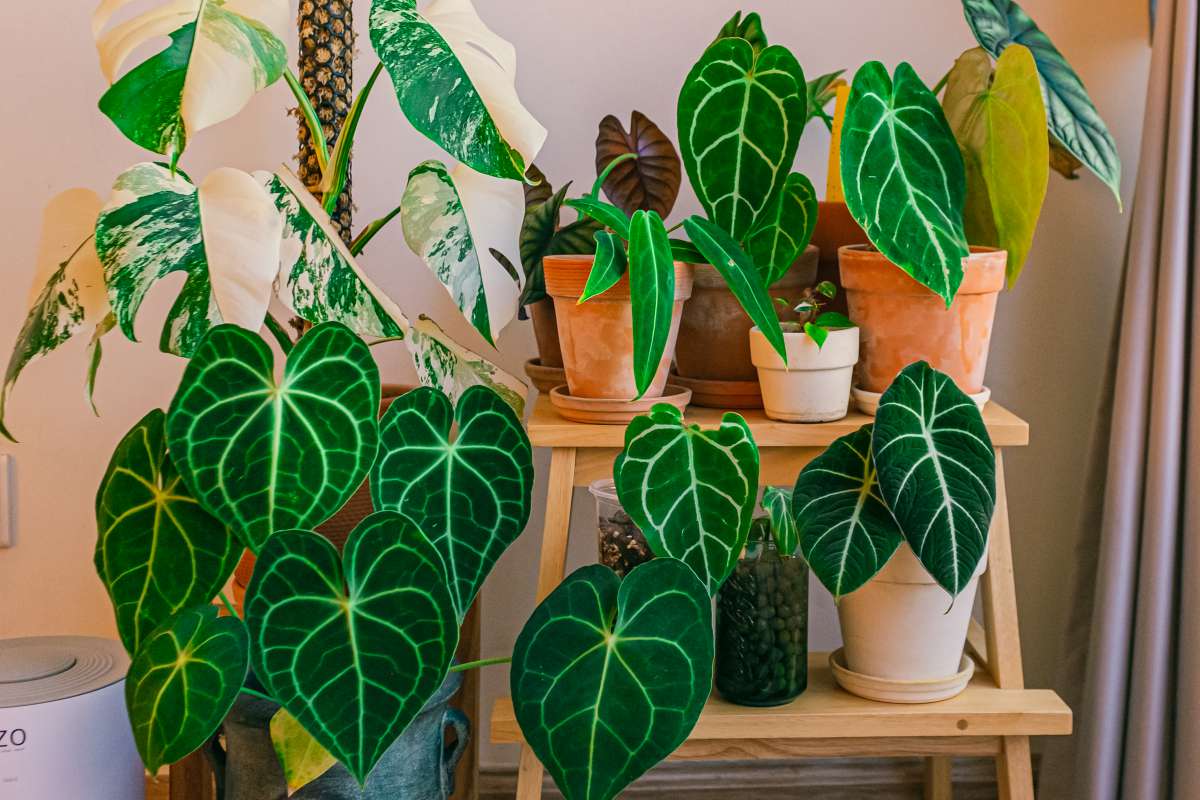
Anthuriums, being tropical plants, will absolutely thrive if you can provide them with a high humidity environment. So consider getting a humidifier and keep the humidity around your aroid plant around 60-75% while ensuring that there is also an adequate amount of airflow. Use a small fan for that.
Bear in mind, however, that a humidifier is not a must as Anthurium plants can also be successfully grown in a normal room-humidity environment as long as they are acclimatized to it.
Wondering how the measure the humidity in a room? Use a hygrometer.
If your Flamingo Flower is enjoying itself without an extra humidity boost, keep in mind that if the humidity levels drop suddenly, the plant might show signs of distress. For instance, when heaters are used to warm up a room, the humidity levels usually decrease quite rapidly. Make sure that your Anthurium is placed away from any direct exposure to heaters and if you notice that the plant is getting brown edges or the leaves look as if they lost some color, a humidifier might come in handy.
6. The Best Temperature Ranges for an Anthurium
Anthuriums hate being cold.
As mentioned, Anthuriums can be grown as indoor and as outdoor plants. Make sure that when the weather starts getting chilly to protect your Anthurium from any extreme weather conditions. They will not survive frost and any temperatures below 10°C (50°F) will stop their growth, so if the temperatures start dropping, it’s time to bring your Flamingo Flower in for the colder seasons.
Anthuriums can tolerate the following temperature range: 12°C to 36°C (53.6°F to 96.8°F ). However, it is advisable to not keep your Flamingo Flower at those extremes. The ideal growing temperatures for Anthuriums are the same as normal room temperatures in most households: 17°C-23°C (63°F-74°F). Anthuriums can tolerate relatively high temperatures but if there is a sudden spike, the plants might become stressed and the foliage might start to look droopy.
7. How to Replant (Repot) an Anthurium
Before you decide that your Anthurium needs to be replanted in a new pot, ensure that this would actually benefit the plant.
Repotting a plant is stressful for them and a lot of people repot their plants too early and without any actual need. That’s why make sure to read our detailed guide on how to repot your houseplants correctly and when to is the best time to do it.
In short, if your Anthurium has just arrived from its journey to you and if it’s in a pot, stable, don’t do anything for at least 2 weeks until the plant has managed to rest a bit after its travels.
Generally, Anthuriums would need to be transplanted (repotted) to a larger pot every 2-3 years but this time frame can vary depending on how fast is your Flamingo Flower growing. The best time to give your Anthurium a new pot is while it is actively growing, aka from spring till fall. If your Anthurium is not actively growing, it is best to wait till the weather gets warmer and the plant becomes more active.
To replant your Anthurium, choose the next size pot. Never choose a pot that is too large for your Anthurium as these tropical plants might develop root rot quite fast. Also, ensure to plant your Anthurium in a growing media that provides superb air permeability while staying moist. An aroid potting mix is just what your Anthurium would love.
The roots of the majority of the Anthuriums look a lot like those of orchids. They are thick and juicy and not very flexible. That’s why be very gentle with the roots of your Flamingo Flower to avoid any root damage while you are repotting it. Your Anthurium might take some time to acclimatize but as soon as a new leaf pops up, you would know that your repotting actions were successful and that your aroid plant is settled and feels well in its new pot.
8. How to Propagate Anthurium Plants
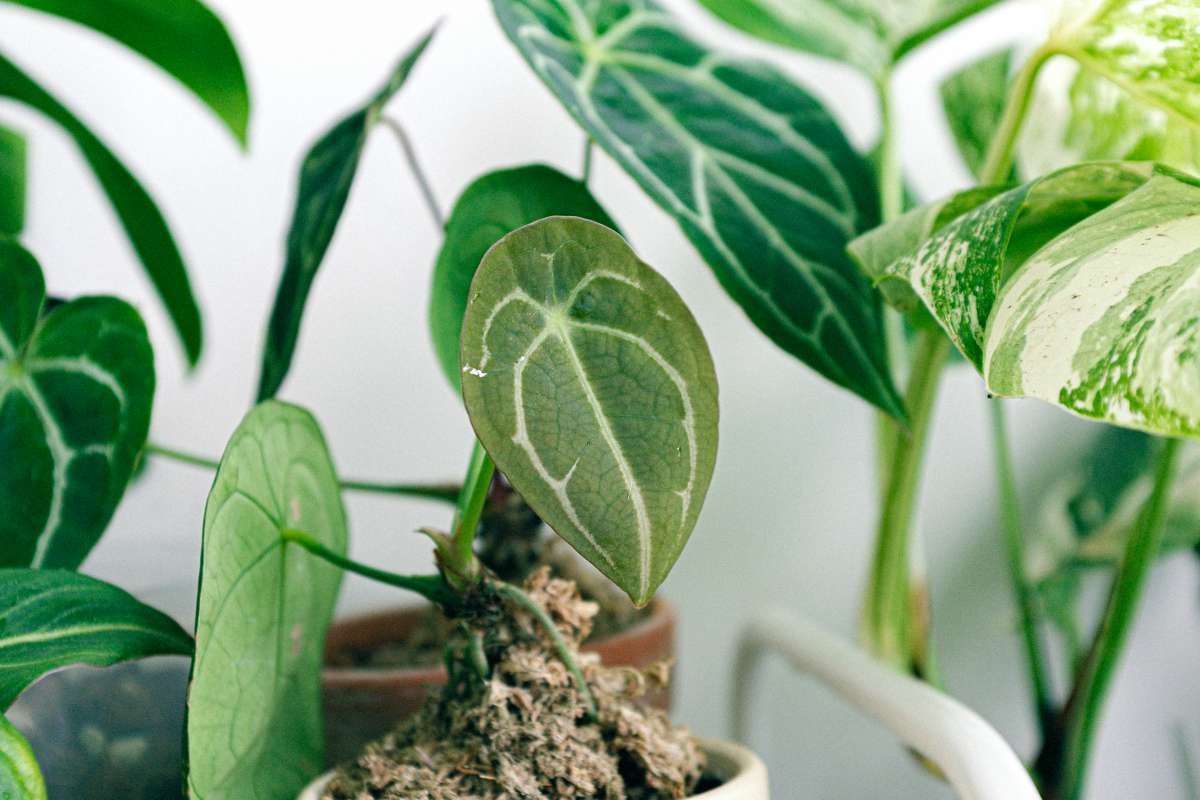
Before you proceed with any propagation method, ensure that your Anthurium is still actively growing and is not in its semi-dormant stage. As a general rule, if plants are not growing, you shouldn’t attempt to propagate them either as this might over-stress the mother plant and might result in a decreased probability of the propagation being successful.
Anthuriums are easy to propagate and if done right, you can soon have another Anthurium baby (or two!). The best time to propagate the Flamingo Flower is in spring and summer, sometimes fall can work too but that depends on their growing speed.
There are multiple ways through which you can propagate your Anthurium: through seeds, division, and by taking stem cuttings. Most commonly, Anthuriums are propagated through division and through stem-cuttings, as seeds are viable only for a short amount of time and are not so easy to obtain.
To propagate your Anthurium through division, you would need to get your plant out of its pot and locate sections on the stem that have at least 2-3 leaves with roots attached to them. Using a sharp cutting tool that has been properly disinfected, you need to divide the stem into parts. After the cut ends have formed callus, you can plant them directly in an aroid potting mix.
If you are ready to roll-up your sleeves and propagate your Anthurium through division, make sure to read our step-by-step guide on Plants Propagation Through Division Made Easy.
Can you propagate an Anthurium from only a stem with roots but without leaves? Yes, if that portion of the stem has nodes, aka called the rhizome. They look like little elevated dots on the stem. Follow the above-mentioned steps and ensure that when you are potting the stem, that the upper part where the first node is, is staying above ground. Surely, in no time, you will see a new leaf coming from there. How exciting!
Alternatively, if you don’t feel like digging up your Anthurium and if your plant is mature enough, you can propagate it through stem cuttings that you need to root afterward. We have a very detailed guide to make your propagation journey peace of cake.
How to propagate Anthurium from cuttings with ease? Check out now our Plant Propagation Through Stem Cuttings Made Easy step-by-step article.
But in short: To propagate your Anthurium through stem cuttings you need to locate portions on the aboveground stem part of your Anthurium that contain nodes and ideally some aerial roots (although the aerial roots are not a must). Next, arm yourself with disinfected garden shears and start separating the stem into smaller chunks. After the cuts callus by allowing them to air dry, you can proceed with rooting your Anthurium cuttings. Anthurium cuttings can root with ease in damp sphagnum moss, semi-hydro media (like perlite or LECA), or planted directly in a chunky, aroid growing mix. Water propagating your Anthurium is another option and is especially useful if you plant to grow your Anthurium in hydro or semi-hydro media.
Make sure to keep your Flamingo Flower cuttings warm and moist while they are rooting, and provide them with gentle but bright light.
Should you use air-layering to propagate an Anthurium? You can also use the air-layering technique to root your cuttings first and then separate them from your mommy Anthurium but in most cases, the extra hassle is not worth it as Anthuriums root with ease. Air-layering involves wrapping your Anthurium with damp sphagnum moss around the nodes where you would like to separate. Keep the moss moist but not soggy at all times and whenever you see that roots have started forming in the moss ball, you can separate your little Anthuriums and plant them directly in an aroid potting mix.
How long does it take for Anthurium cuttings to root? As with every plant, there is no ‘one size fits all to this question. But as a general rule, your Anthurium cuttings should start forming little roots within 2 months.
Propagation of Anthuriums from seeds:
If you want to try to pollinate your Anthurium and propagate it from seeds, we have a step-by-step guide on propagating Anthurium plants from seeds. The guide includes how to pollinate your Anthurium, how to gather the berries, and how to germinate the seeds.
For a short explanation on how to propagate Anthuriums through seeds, read below.
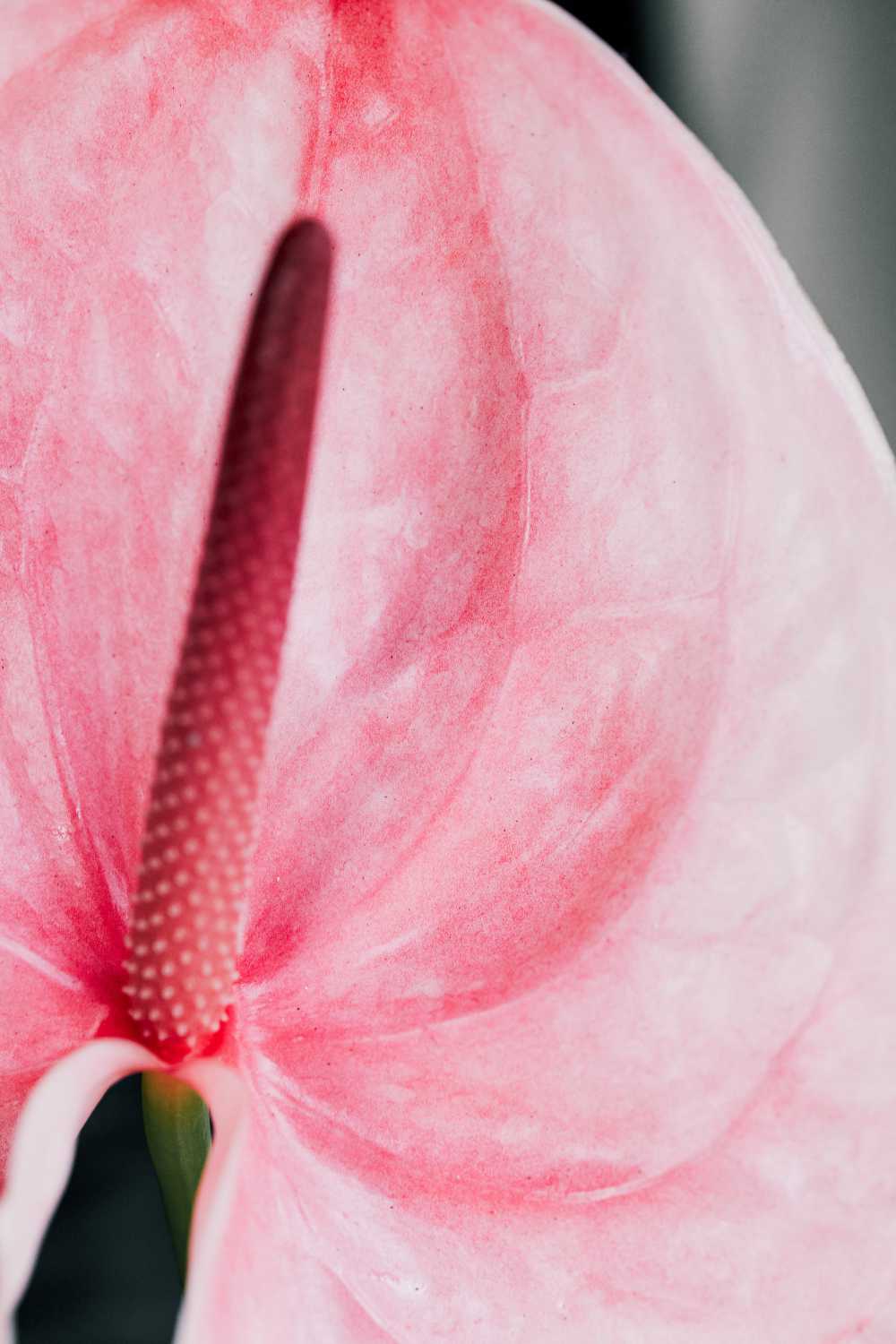
Propagation through seed is the bumble-bee path of work (assuming you don’t already have a seed). If you have one Anthurium you will need at least 2 cycles of flowering so that you can pollinate your Anthurium. This is because the stick-looking part inside the colorful ‘flower’ that you see (which is actually not the flower of the Anthurium but merely a leaf), the spadix, is the reproductive organ of an Anthurium which is both female and male but not at the same time. The spadix goes through a female (receptive phase) at first where little droplets of sticky fluid accumulate in hopes of catching some pollen. After the female phase ends (approximately a week after it has begun), the male phase begins. During this phase, your Anthurium produces pollen which you can collect with the help of a brush and store securely and wait for the next flower cycle. Make sure that the pollen which you have collected is stored somewhere dry and cold.
After you have collected a sufficient amount of pollen (you can collect it every couple of days or so), you can cut off the bloom so that your Anthurium is not wasting unnecessary energy on it. When the second cycle of flowering begins and as soon as at least half of the spadix exhibits the above-mentioned fluid droplets, with the help of a clean brush, you can use your pollen to gently rub it along the spadix. And then wait.
Some Anthuriums will show almost immediately that the pollination has been successful and the spadix will start swelling while berries are getting formed. However, some Anthuriums will go through a male stage first and then show signs of pollination so before you cut off your male spadix thinking it has not been pollinated wait.
Once pollinated, the berries can take up to 6 months to mature and be ready to harvest and propagate. During this time, ensure that your mother plant is receiving excellent care and nutrition as having berries takes quite the energy of a plant, so if your plant is young and stressed and not strong enough, do not attempt to pollinate it.
Once your berries are ready to harvest (you would know this as they will be really easy to pop from the spadix), you need to clean the flesh from around the seed fully. Then you can lay them in a blanket layer of moist sphagnum moss and keep them warm and safe. In about a week, you should see new sprouts coming up and your baby Anthuriums growing.
9. Keep Your Anthurium’s Leaves Clean
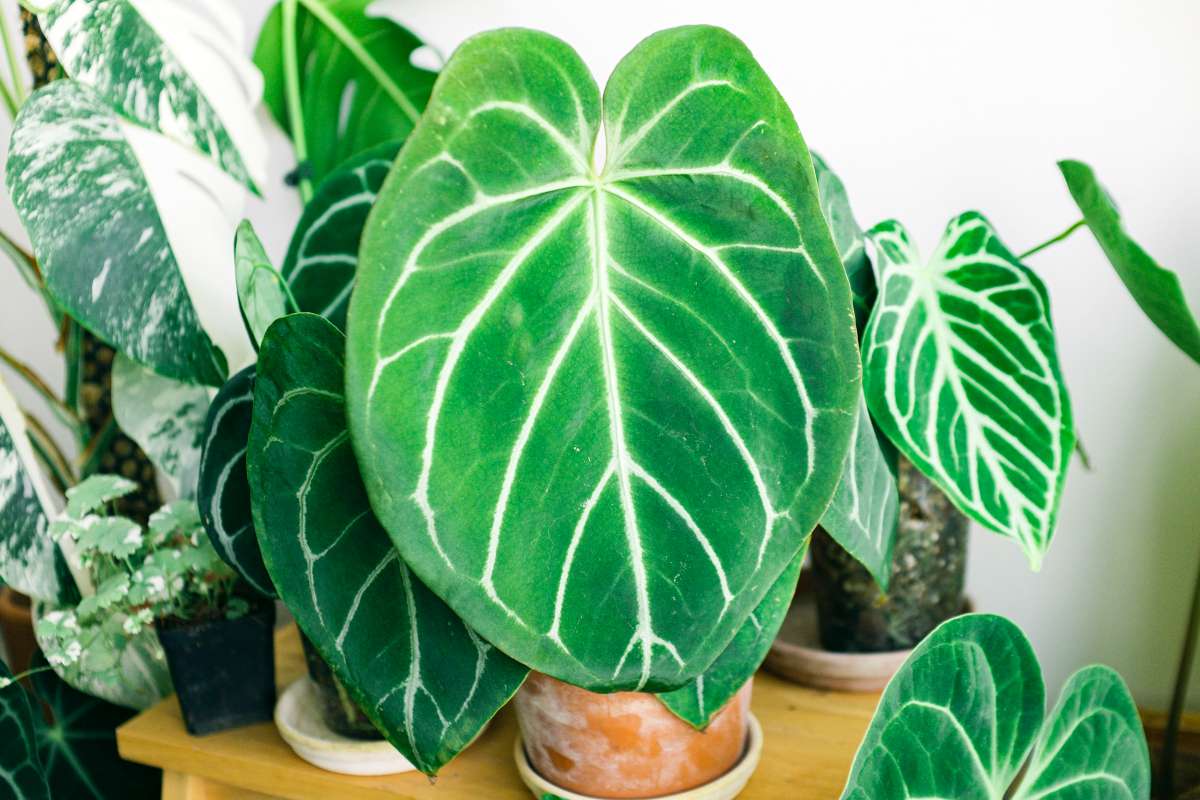
Proper Anthurium care involves some foliage maintenance too. Dust can accumulate on the velvety leaves of Anthuriums quite fast, so to ensure that your Flamingo Flower is able to transpire and photosynthesize at its best, clean your Anthurium leaves regularly. Since Anthuriums grow in a much more compact way as compared to a Monstera, for example, you can simply take your heart-shaped plant to the bathtub and give it a good shower when you notice that its leaves are starting to become dirty. The best time to do this would be first thing in the morning so that your Anthurium would have sufficient time to dry out during the day.
When hard water is used to water an Anthurium, there is mineral build-up that shows on the leaves. They look a bit like white powder and are not so easy to remove. To remove these mineral stains from your Anthurium leaves, you can use a clean soft towel and add a spoon of vinegar or lemon juice in 250ml (one cup) of lukewarm water. Apply the mixture to the leaves and wait 10 minutes. Then gently scrub the leaf without damaging it. Make sure to clean the entire leaf with freshwater afterward to remove any acid residues.
If you want to avoid mineral stains from showing up on your precious Anthurium, consider switching the water that you are using to irrigate it. Rainwater works great for these tropical plants. Alternatively, if you cannot get rainwater, at least consider using a filter for your tap water.
Keeping your Anthurium’s leaves nice and clean is important for the overall health and well-being of your Flamingo Flower, and also, it discourages pests from settling down on your plant.
10. How to Identify & Treat Pests on Anthurium
Anthuriums are usually not likable by pests (phew!) and they really rarely get unwanted visitors. To keep them this way, make sure to inspect your Anthurium thoroughly (underside of leaves and stems too!) every couple of weeks or so for any signs of bugs.
Pests on Anthuriums are manageable if caught early on, so if you suspect that something might be off with your Flamingo Flower, check our guide on how to identify and treat pests on houseplants.
The most common insects that Anthuriums can suffer from are the sucking ones, i.e. they literally suck out the juice from the leaves, leaving the plant looking wilting and yellowing. Those include mainly aphids, spider mites, thrips and scale insects. Usually, the target of the sap-sucking pests are the newest leaves as they are the most vulnerable.
For treatment we recommend to isolate the affected plant(s) to prevent the pests from spreading throughout your whole plant family. It is best to start by giving the plant a good shower as to get rid off as many insects as possible. Start treatment with an organic insecticidal pesticide (for example alcohol, soap, neem oil or hommade tinctures) with multiple applications when necessary. Consider introducing beneficial insects for prevention and control of pests in the future.
11. Anthurium Care: Common Plant Issues
Are the leaves on your Anthurium turning yellow? Bear in mind that a single leaf turning yellow on any plant (yes, the Flamingo Flower included) is not a cause for concern as leaves don’t live forever. As a result, it is completely normal from time to time for an old leaf on your Anthurium to turn yellow and fall off. However, if the leaves of your aroid plant are starting to rapidly turn yellow, and it seems more of a pattern rather than a singular case, then it could be that your Anthurium is experiencing some sort of stress or a disease.
There are different causes of leaves turning yellow on plants. Read our detailed guide on how to find the reason of leaves turning yellow on your Anthurium and how to correct the environmental factor so that your Flamingo Flower can thrive again.
The most common issues when it comes to Anthuriums are caused by overwatering. These plants are particularly susceptible to stem and root rot issues. To avoid these common reasons why Anthuriums lose vigor: ensure that your aroid plant is potted in a well-draining, chunky, growing medium and is allowed some time to dry partially between watering.
If you suspect that your Anthurium has fallen victim to stem or root rot, make sure to check our detailed guide on identification and treatment of rot issues in plants straight away as these common houseplant problems are manageable if caught early on, so don’t delay.
Rarely, fungal diseases can affect the foliage of Anthuriums. Fungus thrives in environments with high humidity and a low amount of airflow. To avoid your Flamingo Flower suffering from fungal issues, ensure that there is constant air movement around it and that the air is not remaining sticky. Avoid misting your Anthurium in the colder months as this might promote fungal problems. In fact, we don’t mist our Anthuriums as we find there is little benefit to misting houseplants in general but comes with risks of creating an environment where pathogens can spread and grow on plants.
If you suspect that your Anthurium is suffering from a fungal infection, separate it from the rest of your plant collection immediately and treat it with a copper-based fungicide; re-apply if needed. Fungal spores are light and can easily travel and be spread through air and water, so if one plant is sick, the best practice is to also treat your nearby plants preventively as well.
12. Can You Grow Anthurium in a Terrarium?
If you too have been facinated about creating your little tropical plant eco-system in a terrarium, you might be wondering if it’s a good idea to include your Anthurium in it. It is possible to grow the Flamingo Flower in a terrarium but there are a couple of drawbacks to this. Anthuriums grow moderately fast, however, their new growth tends to stretch up, towards the light while not remaining really compact and could potentially press on other plants in the terrarium. This means that unless you have a baby Anthurium, your aroid plant might outgrow its enclosure quite fast, so you would need to think big when it comes to choosing the size of the terrarium for your heart-shaped plant. If you still want to try to grow your Anthurium in a terrarium, we have a terrarium DIY set at our shop that includes the substrates needed for your Anthurium-jar-adventure.
However, unlike Succulents & Cacti, we find that Anthuriums aren’t ideally suited to be terrarium-plants.
And if you already have everything needed, make sure to check our step-by-step guide on how to build a plant terrarium from scratch.
13. Are Anthurium Plants Toxic?
Unfortunately, your Anthurium is not pet-friendly.
Similar to other Araceae family members, Anthuriums too contain insoluble calcium oxalate crystals which are irritants if swallowed. These toxins can irritate the mouth and the gastrointestinal (GI) tract and cause vomiting. Rarely, there is also swelling of the upper respiratory tract observed.
Although there are no known longer-term health side effects if an Anthurium leaf is chewed upon, this should be avoided. Ensure that you choose a spot for your Anthurium where your pet or child can’t reach it.
Anthurium Houseplant Care: Final Thoughts
If you like unique, easy to care for plants that naturally attractively display long-lasting flowers, you’ve probably considered bringing home an Anthurium. These wonderful plants are not only aesthetically pleasing; they’re also quite easy to grow!
Flamingo Flowers are an excellent choice for plant beginners as they are low-maintenance and can bounce back quite fast if they were under stress. Anthuriums thrive when they are receiving sufficient light and require regular watering, however, soggy conditions should be avoided as these plants are known to be prone to root rot diseases.
From the whole Araceae family, Anthuriums are the ones that hold my heart the most and for a good reason: with over 1000 different varieties, their heart-shaped leaves look absolutely stunning and unique and they are a must-have for any plant lover!

